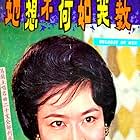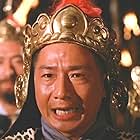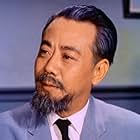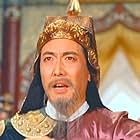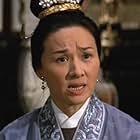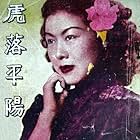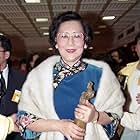IMDb RATING
6.9/10
54
YOUR RATING
The story traces the relationships that develop between the protagonist Xu and the three women he meets, set against the backdrop of the Second World War.The story traces the relationships that develop between the protagonist Xu and the three women he meets, set against the backdrop of the Second World War.The story traces the relationships that develop between the protagonist Xu and the three women he meets, set against the backdrop of the Second World War.
- Director
- Writers
- Stars
- Awards
- 4 wins
Photos
Patsy Chia-Ling
- Zhizhong's Mother
- (as Ling Jia)
Ching Lin
- Qiuming's Mother
- (as Jing Lin)
- Director
- Writers
- All cast & crew
- Production, box office & more at IMDbPro
Storyline
Did you know
- ConnectionsReferenced in What Time Is It There? (2001)
Featured review
SUN, MOON AND STAR is a compelling romantic drama filmed in color, in two parts, in 1961 by Cathay, a Hong Kong studio that thrived in the late 1950s and early '60s before losing market share to its well-financed rival, Shaw Bros. Cathay tended to focus on intimate dramas and comedies focusing on the ordinary workaday people of Hong Kong and China as opposed to Shaw's more lavish Hollywood-style productions.
SUN, MOON AND STAR tells the story of a young man, Jianbai (Yang Zhang), from a well-off family in southern China and the three women he falls in love with in a period spanning the years of Japanese invasion, occupation and aftermath in the 1930s and '40s. The title refers to the symbols Jianbai applies to each of the three women. "Star" is his childhood sweetheart, A-Lan (Lucilla You Min), a country girl and orphan who lives with an abusive aunt and uncle who try to marry her off to an army officer. "Moon" is Qiuming (Grace Chang), a cousin of Jianbai's from a good family. She's a virtuoso piano player and singer and is the more cosmopolitan one, always well dressed, the perfect hostess, somewhat impetuous, but always nurturing and gracious. "Sun" is Su Yanan (Julie Yeh Feng), a student activist who later becomes a soldier in the Nationalist army and fights the Japanese in combat. She's a woman of action and devotes herself to larger causes than personal happiness. Jianbai's indecisiveness regarding the women (each of whom gets a marriage proposal from him at different points in the story) causes problems for everybody in the course of the decade-plus span of the film.
Based on a popular, serialized novel by Xu Su, the film was released in two parts, totaling three-and-a-half hours. Part 1 ends rather abruptly as Jianbai and Su Yanan flee with the other university students to the countryside as the Japanese invade. Part 2 (reviewed separately on this site) should be seen right after Part 1 since it really is all one movie.
One of the chief selling points of this movie is the rich and beautiful film color, as captured on the Panorama DVD. This approximates what we might have seen on a movie screen back in 1961, as opposed to the digitally enhanced restored color we see in the Shaw Bros. DVDs coming out from Celestial, which are clean and bright and, admittedly, a welcome relief from the degraded pan-and-scan VHS tapes we've had to make do with for years, but look nothing like the way the films did when they ran in theaters decades ago. (I'm not complaining--believe me, I'd rather have the Celestial DVDs than unrestored copies--I'm just pointing out the contrast in the color.) The other big selling point is the cast. The three lead actresses are nothing short of magnificent. They are beautiful, but in a down-to-earth, believable way, in contrast to the glamorous, more idealized Shaw Bros. stars of the era (e.g. Linda Lin Dai, Betty Loh Ti and Lily Ho). Two of the actresses here play extended scenes without makeup and are just as magnetic. They have great faces and the filmmakers give them lots of closeups.
SUN, MOON AND STAR tells the story of a young man, Jianbai (Yang Zhang), from a well-off family in southern China and the three women he falls in love with in a period spanning the years of Japanese invasion, occupation and aftermath in the 1930s and '40s. The title refers to the symbols Jianbai applies to each of the three women. "Star" is his childhood sweetheart, A-Lan (Lucilla You Min), a country girl and orphan who lives with an abusive aunt and uncle who try to marry her off to an army officer. "Moon" is Qiuming (Grace Chang), a cousin of Jianbai's from a good family. She's a virtuoso piano player and singer and is the more cosmopolitan one, always well dressed, the perfect hostess, somewhat impetuous, but always nurturing and gracious. "Sun" is Su Yanan (Julie Yeh Feng), a student activist who later becomes a soldier in the Nationalist army and fights the Japanese in combat. She's a woman of action and devotes herself to larger causes than personal happiness. Jianbai's indecisiveness regarding the women (each of whom gets a marriage proposal from him at different points in the story) causes problems for everybody in the course of the decade-plus span of the film.
Based on a popular, serialized novel by Xu Su, the film was released in two parts, totaling three-and-a-half hours. Part 1 ends rather abruptly as Jianbai and Su Yanan flee with the other university students to the countryside as the Japanese invade. Part 2 (reviewed separately on this site) should be seen right after Part 1 since it really is all one movie.
One of the chief selling points of this movie is the rich and beautiful film color, as captured on the Panorama DVD. This approximates what we might have seen on a movie screen back in 1961, as opposed to the digitally enhanced restored color we see in the Shaw Bros. DVDs coming out from Celestial, which are clean and bright and, admittedly, a welcome relief from the degraded pan-and-scan VHS tapes we've had to make do with for years, but look nothing like the way the films did when they ran in theaters decades ago. (I'm not complaining--believe me, I'd rather have the Celestial DVDs than unrestored copies--I'm just pointing out the contrast in the color.) The other big selling point is the cast. The three lead actresses are nothing short of magnificent. They are beautiful, but in a down-to-earth, believable way, in contrast to the glamorous, more idealized Shaw Bros. stars of the era (e.g. Linda Lin Dai, Betty Loh Ti and Lily Ho). Two of the actresses here play extended scenes without makeup and are just as magnetic. They have great faces and the filmmakers give them lots of closeups.
- BrianDanaCamp
- Nov 3, 2006
- Permalink
Details
- Release date
- Country of origin
- Language
- Also known as
- for Xing xing yue liang tai yang
- Production company
- See more company credits at IMDbPro
Contribute to this page
Suggest an edit or add missing content

Top Gap
By what name was Sun, Moon and Star: Part 1 (1961) officially released in Canada in English?
Answer

